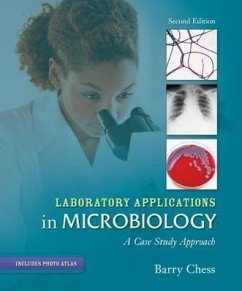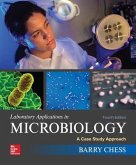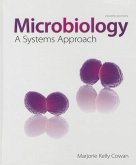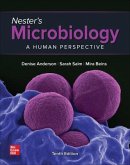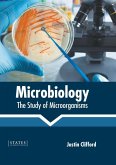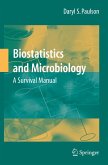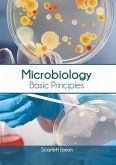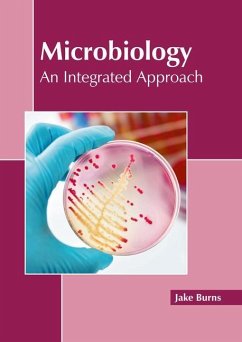Barry Chess
Laboratory Applications in Microbiology: A Case Study Approach
Barry Chess
Laboratory Applications in Microbiology: A Case Study Approach
- Loseblattsammlung
- Merkliste
- Auf die Merkliste
- Bewerten Bewerten
- Teilen
- Produkt teilen
- Produkterinnerung
- Produkterinnerung
"Laboratory Applications in Microbiology: A Case Study Approach" now includes a photo atlas with more than 250 full-color images! This lab uses real-life case studies as the basis for exercises in the laboratory. This is the only microbiology lab manual focusing on this means of instruction, an approach particularly applicable to the microbiology laboratory. The author has carefully organized the exercises so that students develop a solid intellectual base beginning with a particular technique, moving through the case study, and finally applying new knowledge to unique situations beyond the case study.…mehr
Andere Kunden interessierten sich auch für
![Loose Leaf for Laboratory Applications in Microbiology: A Case Study Approach Loose Leaf for Laboratory Applications in Microbiology: A Case Study Approach]() Barry ChessLoose Leaf for Laboratory Applications in Microbiology: A Case Study Approach172,99 €
Barry ChessLoose Leaf for Laboratory Applications in Microbiology: A Case Study Approach172,99 €![Microbiology: A Systems Approach Microbiology: A Systems Approach]() Marjorie Kelly CowanMicrobiology: A Systems Approach317,99 €
Marjorie Kelly CowanMicrobiology: A Systems Approach317,99 €![Loose Leaf for Nester's Microbiology: A Human Perspective Loose Leaf for Nester's Microbiology: A Human Perspective]() Denise G AndersonLoose Leaf for Nester's Microbiology: A Human Perspective176,99 €
Denise G AndersonLoose Leaf for Nester's Microbiology: A Human Perspective176,99 €![Microbiology: The Study of Microorganisms Microbiology: The Study of Microorganisms]() Microbiology: The Study of Microorganisms162,99 €
Microbiology: The Study of Microorganisms162,99 €![Biostatistics and Microbiology: A Survival Manual Biostatistics and Microbiology: A Survival Manual]() Daryl S. PaulsonBiostatistics and Microbiology: A Survival Manual41,99 €
Daryl S. PaulsonBiostatistics and Microbiology: A Survival Manual41,99 €![Microbiology: Basic Principles Microbiology: Basic Principles]() Microbiology: Basic Principles159,99 €
Microbiology: Basic Principles159,99 €![Microbiology: An Integrated Approach Microbiology: An Integrated Approach]() Microbiology: An Integrated Approach145,99 €
Microbiology: An Integrated Approach145,99 €-
-
-
"Laboratory Applications in Microbiology: A Case Study Approach" now includes a photo atlas with more than 250 full-color images! This lab uses real-life case studies as the basis for exercises in the laboratory. This is the only microbiology lab manual focusing on this means of instruction, an approach particularly applicable to the microbiology laboratory. The author has carefully organized the exercises so that students develop a solid intellectual base beginning with a particular technique, moving through the case study, and finally applying new knowledge to unique situations beyond the case study.
Hinweis: Dieser Artikel kann nur an eine deutsche Lieferadresse ausgeliefert werden.
Hinweis: Dieser Artikel kann nur an eine deutsche Lieferadresse ausgeliefert werden.
Produktdetails
- Produktdetails
- Verlag: McGraw Hill LLC
- Erscheinungstermin: 7. September 2012
- Englisch
- Abmessung: 272mm x 218mm x 25mm
- Gewicht: 1520g
- ISBN-13: 9780077755492
- ISBN-10: 0077755499
- Artikelnr.: 36398106
- Herstellerkennzeichnung
- Libri GmbH
- Europaallee 1
- 36244 Bad Hersfeld
- gpsr@libri.de
- Verlag: McGraw Hill LLC
- Erscheinungstermin: 7. September 2012
- Englisch
- Abmessung: 272mm x 218mm x 25mm
- Gewicht: 1520g
- ISBN-13: 9780077755492
- ISBN-10: 0077755499
- Artikelnr.: 36398106
- Herstellerkennzeichnung
- Libri GmbH
- Europaallee 1
- 36244 Bad Hersfeld
- gpsr@libri.de
1 Safety Considerations in the Microbiology Laboratory
2 Microscopy and Measurement of Microscopic Specimens
3 A Survey of Protists
4 A Survey of Fungi
5 A Survey of Parasitic Worms
6 Ubiquity of Microorganisms
7 Aseptic and Pure Culture Techniques
8 Simple Staining, Negative Staining, and Gram Staining
9 Capsular Staining
10 Endospore Staining
11 Acid-Fast Staining
12 Viable Plate Count
13 Cultivation of Anaerobes
14 Temperature Effects on Bacterial Growth and Survival
15 pH and Microbial Growth
16 Effects of Osmotic Pressure on Bacterial Growth
17 Lethal Effects of Ultraviolet Light
18 Evaluation of Disinfectants
19 Effectiveness of Hand Scrubbing
20 Antimicrobic Sensitivity Testing: Kirby-Bauer, Tube Dilution, and
ETEST(C) Methods
21 Simulated Epidemic
22 Morbidity and Mortality Weekly Report
23 Bacterial Transformation
24 The Ames Test
25 DNA Extraction from Bacterial Cells
26 DNA Profiling
27 Blood Typing
28 Rapid Identification of Staphylococcus aureus Using Latex Agglutination
Testing
29 Slide Agglutination
30 Enzyme-Linked Immunosorbent Assay (ELISA)
31 Biofilm Culture and Examination
32 Measures of Water Quality: Most Probable Number Procedure
33 Measures of Water Quality: Membrane Filtration Method
34 Measures of Milk Quality: Methylene Blue Reductase Test
35 Bacterial Counts of Food
36 Isolation and Identification of Staphylococci
37 Isolation and Identification of Streptococci
38 Epidemiology of Gastrointestinal Illness: Differentiation of
Enterobacterlaceae
39 Differential White Blood Cell Count
40 Identification of Bacterial Unknowns
41 Colony Morphology
42 Growth in Solid and Liquid Media
43 Motilty Methods: Wet Mount and Hanging Drop
44 Flagella Stain
45 Streak-Plate Isolation
46 Loop Dilution
47 Spread-Plate
48 Fluid Thioglycollate Medium
49 CHROMagar Orientation Medium
50 Mannitol Salt Agar
51 MacConkey Agar
52 Desoxycholate Agar
53 Endo Agar
54 Eosin Methylene Blue Agar
55 Hektoen Enteric Agar
56 Xylose Lysine Desoxycholate Agar
57 Blood Agar
58 Motility Medium
59 SIM Medium
60 Kligler's Iron Agar
61 Triple Sugar Iron Agar
62 Lysine Iron Agar
63 Litmus Milk
64 Oxidation-Fermentation Test
65 Phenol Red Carbohydrate Broth
66 Purple Carbohydrate Broth
67 Methyl Red and Voges-ProskauerTests
68 Catalase Test
69 Oxidase Test
70 Nitrate Reduction Test
71 Coagulase Test
72 Citrate Test
73 Malonate Test
74 Amino Acid Decarboxylation Test
75 Phenylalanine Deaminase Test
76 Bile Esculin Test
77 Starch Hydrolysis
78 ONPG Test
79 Urease Test
80 Casease Test
81 Gelatinase Test
82 DNase Test
83 Lipase Test
84 CAMP Test
85 PYR Test
86 API 20E System
87 EnteroPluri-Test System
88 Antibiotic Disk Sensitivity Tests
89 B-Lactamase Test
90 Viable Plate Count
91 Direct Cell Count
2 Microscopy and Measurement of Microscopic Specimens
3 A Survey of Protists
4 A Survey of Fungi
5 A Survey of Parasitic Worms
6 Ubiquity of Microorganisms
7 Aseptic and Pure Culture Techniques
8 Simple Staining, Negative Staining, and Gram Staining
9 Capsular Staining
10 Endospore Staining
11 Acid-Fast Staining
12 Viable Plate Count
13 Cultivation of Anaerobes
14 Temperature Effects on Bacterial Growth and Survival
15 pH and Microbial Growth
16 Effects of Osmotic Pressure on Bacterial Growth
17 Lethal Effects of Ultraviolet Light
18 Evaluation of Disinfectants
19 Effectiveness of Hand Scrubbing
20 Antimicrobic Sensitivity Testing: Kirby-Bauer, Tube Dilution, and
ETEST(C) Methods
21 Simulated Epidemic
22 Morbidity and Mortality Weekly Report
23 Bacterial Transformation
24 The Ames Test
25 DNA Extraction from Bacterial Cells
26 DNA Profiling
27 Blood Typing
28 Rapid Identification of Staphylococcus aureus Using Latex Agglutination
Testing
29 Slide Agglutination
30 Enzyme-Linked Immunosorbent Assay (ELISA)
31 Biofilm Culture and Examination
32 Measures of Water Quality: Most Probable Number Procedure
33 Measures of Water Quality: Membrane Filtration Method
34 Measures of Milk Quality: Methylene Blue Reductase Test
35 Bacterial Counts of Food
36 Isolation and Identification of Staphylococci
37 Isolation and Identification of Streptococci
38 Epidemiology of Gastrointestinal Illness: Differentiation of
Enterobacterlaceae
39 Differential White Blood Cell Count
40 Identification of Bacterial Unknowns
41 Colony Morphology
42 Growth in Solid and Liquid Media
43 Motilty Methods: Wet Mount and Hanging Drop
44 Flagella Stain
45 Streak-Plate Isolation
46 Loop Dilution
47 Spread-Plate
48 Fluid Thioglycollate Medium
49 CHROMagar Orientation Medium
50 Mannitol Salt Agar
51 MacConkey Agar
52 Desoxycholate Agar
53 Endo Agar
54 Eosin Methylene Blue Agar
55 Hektoen Enteric Agar
56 Xylose Lysine Desoxycholate Agar
57 Blood Agar
58 Motility Medium
59 SIM Medium
60 Kligler's Iron Agar
61 Triple Sugar Iron Agar
62 Lysine Iron Agar
63 Litmus Milk
64 Oxidation-Fermentation Test
65 Phenol Red Carbohydrate Broth
66 Purple Carbohydrate Broth
67 Methyl Red and Voges-ProskauerTests
68 Catalase Test
69 Oxidase Test
70 Nitrate Reduction Test
71 Coagulase Test
72 Citrate Test
73 Malonate Test
74 Amino Acid Decarboxylation Test
75 Phenylalanine Deaminase Test
76 Bile Esculin Test
77 Starch Hydrolysis
78 ONPG Test
79 Urease Test
80 Casease Test
81 Gelatinase Test
82 DNase Test
83 Lipase Test
84 CAMP Test
85 PYR Test
86 API 20E System
87 EnteroPluri-Test System
88 Antibiotic Disk Sensitivity Tests
89 B-Lactamase Test
90 Viable Plate Count
91 Direct Cell Count
1 Safety Considerations in the Microbiology Laboratory
2 Microscopy and Measurement of Microscopic Specimens
3 A Survey of Protists
4 A Survey of Fungi
5 A Survey of Parasitic Worms
6 Ubiquity of Microorganisms
7 Aseptic and Pure Culture Techniques
8 Simple Staining, Negative Staining, and Gram Staining
9 Capsular Staining
10 Endospore Staining
11 Acid-Fast Staining
12 Viable Plate Count
13 Cultivation of Anaerobes
14 Temperature Effects on Bacterial Growth and Survival
15 pH and Microbial Growth
16 Effects of Osmotic Pressure on Bacterial Growth
17 Lethal Effects of Ultraviolet Light
18 Evaluation of Disinfectants
19 Effectiveness of Hand Scrubbing
20 Antimicrobic Sensitivity Testing: Kirby-Bauer, Tube Dilution, and
ETEST(C) Methods
21 Simulated Epidemic
22 Morbidity and Mortality Weekly Report
23 Bacterial Transformation
24 The Ames Test
25 DNA Extraction from Bacterial Cells
26 DNA Profiling
27 Blood Typing
28 Rapid Identification of Staphylococcus aureus Using Latex Agglutination
Testing
29 Slide Agglutination
30 Enzyme-Linked Immunosorbent Assay (ELISA)
31 Biofilm Culture and Examination
32 Measures of Water Quality: Most Probable Number Procedure
33 Measures of Water Quality: Membrane Filtration Method
34 Measures of Milk Quality: Methylene Blue Reductase Test
35 Bacterial Counts of Food
36 Isolation and Identification of Staphylococci
37 Isolation and Identification of Streptococci
38 Epidemiology of Gastrointestinal Illness: Differentiation of
Enterobacterlaceae
39 Differential White Blood Cell Count
40 Identification of Bacterial Unknowns
41 Colony Morphology
42 Growth in Solid and Liquid Media
43 Motilty Methods: Wet Mount and Hanging Drop
44 Flagella Stain
45 Streak-Plate Isolation
46 Loop Dilution
47 Spread-Plate
48 Fluid Thioglycollate Medium
49 CHROMagar Orientation Medium
50 Mannitol Salt Agar
51 MacConkey Agar
52 Desoxycholate Agar
53 Endo Agar
54 Eosin Methylene Blue Agar
55 Hektoen Enteric Agar
56 Xylose Lysine Desoxycholate Agar
57 Blood Agar
58 Motility Medium
59 SIM Medium
60 Kligler's Iron Agar
61 Triple Sugar Iron Agar
62 Lysine Iron Agar
63 Litmus Milk
64 Oxidation-Fermentation Test
65 Phenol Red Carbohydrate Broth
66 Purple Carbohydrate Broth
67 Methyl Red and Voges-ProskauerTests
68 Catalase Test
69 Oxidase Test
70 Nitrate Reduction Test
71 Coagulase Test
72 Citrate Test
73 Malonate Test
74 Amino Acid Decarboxylation Test
75 Phenylalanine Deaminase Test
76 Bile Esculin Test
77 Starch Hydrolysis
78 ONPG Test
79 Urease Test
80 Casease Test
81 Gelatinase Test
82 DNase Test
83 Lipase Test
84 CAMP Test
85 PYR Test
86 API 20E System
87 EnteroPluri-Test System
88 Antibiotic Disk Sensitivity Tests
89 B-Lactamase Test
90 Viable Plate Count
91 Direct Cell Count
2 Microscopy and Measurement of Microscopic Specimens
3 A Survey of Protists
4 A Survey of Fungi
5 A Survey of Parasitic Worms
6 Ubiquity of Microorganisms
7 Aseptic and Pure Culture Techniques
8 Simple Staining, Negative Staining, and Gram Staining
9 Capsular Staining
10 Endospore Staining
11 Acid-Fast Staining
12 Viable Plate Count
13 Cultivation of Anaerobes
14 Temperature Effects on Bacterial Growth and Survival
15 pH and Microbial Growth
16 Effects of Osmotic Pressure on Bacterial Growth
17 Lethal Effects of Ultraviolet Light
18 Evaluation of Disinfectants
19 Effectiveness of Hand Scrubbing
20 Antimicrobic Sensitivity Testing: Kirby-Bauer, Tube Dilution, and
ETEST(C) Methods
21 Simulated Epidemic
22 Morbidity and Mortality Weekly Report
23 Bacterial Transformation
24 The Ames Test
25 DNA Extraction from Bacterial Cells
26 DNA Profiling
27 Blood Typing
28 Rapid Identification of Staphylococcus aureus Using Latex Agglutination
Testing
29 Slide Agglutination
30 Enzyme-Linked Immunosorbent Assay (ELISA)
31 Biofilm Culture and Examination
32 Measures of Water Quality: Most Probable Number Procedure
33 Measures of Water Quality: Membrane Filtration Method
34 Measures of Milk Quality: Methylene Blue Reductase Test
35 Bacterial Counts of Food
36 Isolation and Identification of Staphylococci
37 Isolation and Identification of Streptococci
38 Epidemiology of Gastrointestinal Illness: Differentiation of
Enterobacterlaceae
39 Differential White Blood Cell Count
40 Identification of Bacterial Unknowns
41 Colony Morphology
42 Growth in Solid and Liquid Media
43 Motilty Methods: Wet Mount and Hanging Drop
44 Flagella Stain
45 Streak-Plate Isolation
46 Loop Dilution
47 Spread-Plate
48 Fluid Thioglycollate Medium
49 CHROMagar Orientation Medium
50 Mannitol Salt Agar
51 MacConkey Agar
52 Desoxycholate Agar
53 Endo Agar
54 Eosin Methylene Blue Agar
55 Hektoen Enteric Agar
56 Xylose Lysine Desoxycholate Agar
57 Blood Agar
58 Motility Medium
59 SIM Medium
60 Kligler's Iron Agar
61 Triple Sugar Iron Agar
62 Lysine Iron Agar
63 Litmus Milk
64 Oxidation-Fermentation Test
65 Phenol Red Carbohydrate Broth
66 Purple Carbohydrate Broth
67 Methyl Red and Voges-ProskauerTests
68 Catalase Test
69 Oxidase Test
70 Nitrate Reduction Test
71 Coagulase Test
72 Citrate Test
73 Malonate Test
74 Amino Acid Decarboxylation Test
75 Phenylalanine Deaminase Test
76 Bile Esculin Test
77 Starch Hydrolysis
78 ONPG Test
79 Urease Test
80 Casease Test
81 Gelatinase Test
82 DNase Test
83 Lipase Test
84 CAMP Test
85 PYR Test
86 API 20E System
87 EnteroPluri-Test System
88 Antibiotic Disk Sensitivity Tests
89 B-Lactamase Test
90 Viable Plate Count
91 Direct Cell Count

